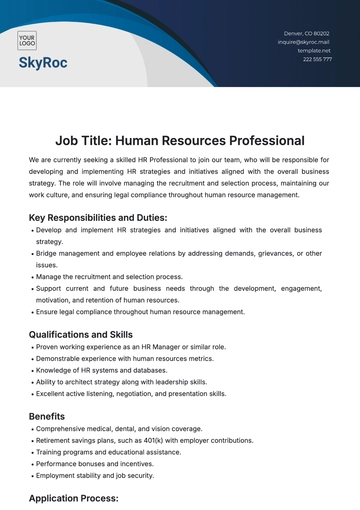Free Diverse Talent Retention Strategy HR

Executive Summary
Our organization, [Your Company], is a forward-thinking tech company committed to creating cutting-edge products and services for a global market. We recognize that diversity and inclusion are essential for innovation and sustained success. This document outlines our strategy to retain and nurture diverse talent within our organization.
Objective
The primary objective of this strategy is to create an inclusive work environment that attracts and retains a diverse workforce. By focusing on talent retention, we aim to harness the unique perspectives and capabilities of our employees, fostering a culture of creativity and excellence.
Scope
This strategy encompasses all aspects of talent retention with a special emphasis on diversity and inclusion. It applies to all employees, from entry-level staff to senior leadership, across all departments and locations of our organization.
Key Findings
Through employee surveys and data analysis, we have identified key findings:
While our organization has made strides in diversity recruitment, retaining diverse talent remains a challenge. | A lack of inclusion and unconscious bias hampers the career progression of many talented individuals. | Effective communication and leadership engagement are vital to overcoming these challenges. |
Recommendations
Our recommendations include:
Implementing targeted retention programs for diverse employees.
Providing unconscious bias training for all staff.
Establishing a mentoring program.
Encouraging flexible work arrangements.
Monitoring progress through KPIs and regular surveys.
Introduction
Diversity refers to the unique characteristics that individuals bring to the workplace, including differences in race, gender, age, sexual orientation, religion, and abilities. Inclusion is the practice of creating an environment where all employees feel valued, respected, and able to contribute their diverse perspectives. Embracing diversity and inclusion promotes creativity and innovation.
Moreover, talent retention is critical for our organization's stability and growth. High turnover rates can lead to increased recruitment costs and disrupt project continuity. Retaining diverse talent is particularly important as it enhances our ability to serve a diverse customer base and fosters a positive company culture.
In that respect, this document serves as a comprehensive guide to our organization's commitment to diversity and inclusion through talent retention. It outlines the strategies and initiatives that will help us create a more inclusive and equitable workplace.
Understanding Diversity and Inclusion
Defining Diversity and Inclusion
Diversity encompasses the range of individual differences among our employees, including but not limited to race, gender, age, ethnicity, disability, and cultural backgrounds. Inclusion is the intentional and ongoing effort to ensure that all individuals feel valued, included, and have an equal opportunity to succeed.
Business Case for Diversity and Inclusion
Research demonstrates that diverse teams are more innovative and better equipped to solve complex problems. Embracing diversity and inclusion not only aligns with our values but also enhances our competitiveness in the global market.
Current State of Diversity in Our Organization
Currently, our organization's workforce is moderately diverse, with representation from various ethnic backgrounds and genders. However, we recognize that there is room for improvement, particularly in leadership roles.
Challenges and Barriers
Identifying Common Challenges
Common challenges include unconscious bias during hiring and promotion processes, lack of diverse role models in leadership positions, and limited awareness of inclusion issues among employees.
Addressing Unconscious Bias
We will address unconscious bias through training programs that educate employees and leaders about the impact of bias and provide tools to mitigate its effects in decision-making.
Communication Gaps
Improving communication will involve creating channels for employees to voice concerns and ideas openly, ensuring transparency in decision-making, and fostering a culture of active listening.
Inclusive Leadership
Leadership training will focus on fostering inclusive behaviors, encouraging diverse perspectives, and actively seeking out and nurturing diverse talent.
Retention Strategies for a Diverse Workforce
In this section, we will explore a range of retention strategies tailored to support our diverse workforce. These strategies are designed to address the unique needs and challenges faced by employees from various backgrounds, ensuring they feel valued, engaged, and motivated to contribute to the organization's success.
STRATEGY | BACKGROUND | ACTION PLAN |
Tailored Onboarding | Effective onboarding |
|
Career Development Programs | Inclusive and provides equal opportunities |
|
Mentorship and Sponsorship | Provide guidance, advocacy, and visibility for employees |
|
Employee Resource Groups (ERGs) | Voluntary, employee-led groups |
|
Flexibility and Work-Life Balance | Accommodate diverse employee needs, such as caregiving responsibilities, health concerns, or cultural practices |
|
Measuring and Evaluating Success
In this section, we outline our approach to measuring and evaluating the success of our diversity and inclusion initiatives. It's crucial to track progress, gather feedback, and analyze data to ensure that our efforts are making a meaningful impact on our workforce and organizational culture.
Key Performance Indicators (KPIs)
Diversity Index (DI) | Retention Rate of Diverse Talent (RRDT) |
The Diversity Index measures the representation of diverse groups within our organization, including gender, ethnicity, age, and more. A higher DI indicates a more diverse workforce, aligning with our commitment to inclusivity. | The Retention Rate of Diverse Talent KPI tracks the percentage of diverse employees who stay with the company over a specified period. A higher RRDT signifies the effectiveness of our talent retention strategies for diverse groups. |
Inclusive Leadership Score (ILS) | Diverse Talent Promotion Rate (DTPR) |
The Inclusive Leadership Score assesses leadership's commitment to diversity and inclusion. It is based on feedback from employees, with a higher ILS indicating stronger leadership support for D&I efforts. | The Diverse Talent Promotion Rate measures the percentage of diverse employees promoted within the organization. This KPI reflects our ability to provide equal advancement opportunities, with a higher DTPR signifying inclusivity in career progression. |
Regular Surveys and Feedback
Collecting feedback from employees is essential for understanding their experiences and identifying areas for improvement. Regular surveys and feedback mechanisms provide employees with a voice and allow us to make data-driven decisions.
Action Steps:
Conduct anonymous surveys to gauge employee perceptions of the workplace climate, inclusion efforts, and career development opportunities.
Analyze survey data to identify trends and areas of concern.
Act on feedback by implementing changes and improvements based on employee input.
Data Collection and Analysis
Data is a powerful tool for assessing the impact of our diversity and inclusion initiatives. By collecting and analyzing demographic data, we can identify disparities and take corrective action.
Action Steps:
Collect and maintain demographic data voluntarily provided by employees.
Regularly review this data to identify trends and gaps.
Use data insights to inform decision-making and adjust strategies to address disparities.
Implementation Plan
The successful execution of our Diverse Talent Retention Strategy relies heavily on a well-structured implementation plan. This section details four crucial components that will guide our efforts in creating an inclusive workplace where diverse talent not only thrives but also remains committed to our organization.
Leadership Engagement
Fostering Inclusive Leadership: Leadership plays a pivotal role in setting the tone for diversity and inclusion within our organization. We will actively engage and educate our leaders on the benefits of diverse teams and the necessity of leading by example. This involves leadership training programs that emphasize the importance of empathy, cultural competence, and fairness in decision-making.
Accountability and Goal Setting: Leaders will be encouraged to set diversity and inclusion goals for their teams and departments. These goals will be closely monitored, and progress will be tied to performance evaluations and compensation. By holding leaders accountable, we ensure that diversity and inclusion are integrated into our organizational culture.
Training and Awareness
Diversity and Inclusion Training: We will implement comprehensive diversity and inclusion training programs for all employees. These programs will be tailored to address unconscious bias, microaggressions, and the importance of inclusive language. Regular training sessions will ensure that our workforce is equipped with the knowledge and skills needed to foster an inclusive environment.
Promoting Awareness: Beyond formal training, we will launch awareness campaigns and initiatives to create an inclusive mindset. This includes celebrating cultural heritage months, hosting diversity dialogues, and spotlighting diverse employees' stories and achievements. Building awareness will foster a sense of belonging and respect across the organization.
ERG Support and Resources
Strengthening Employee Resource Groups (ERGs): Our ERGs are vital pillars of our diversity and inclusion strategy. We will provide increased support and resources to these groups, allowing them to thrive and create meaningful change. This includes dedicated budgets, access to leadership, and opportunities to influence decision-making.
ERG Expansion: We will actively encourage the formation of new ERGs to reflect the diverse interests and identities within our workforce. These groups will have the autonomy to drive initiatives that align with our diversity and inclusion goals.
Continuous Improvement
Feedback Mechanisms: We recognize the importance of feedback in our journey towards a more inclusive workplace. We will establish regular feedback mechanisms, such as surveys and focus groups, to gather insights from employees at all levels. Feedback will inform our ongoing efforts and guide necessary adjustments.
Data-Driven Decisions: We will leverage data analytics to monitor the impact of our diversity and inclusion initiatives. Key performance indicators (KPIs) will be tracked to measure progress, and regular reports will be generated to assess the effectiveness of our strategies.
Adaptation and Flexibility: The landscape of diversity and inclusion is constantly evolving. We commit to remaining agile and adaptable, adjusting our strategies as needed to address emerging challenges and opportunities.
Budget and Resource Allocation
To successfully implement our Diverse Talent Retention Strategy, we propose the following budget allocation for Diversity and Inclusion Initiatives for the upcoming fiscal year:
Budget for Diversity and Inclusion Initiatives
INITIATIVES | AMOUNT | DETAILS |
Diversity Training Programs | $100,000 | This includes workshops, seminars, and e-learning modules aimed at raising awareness and promoting inclusivity among our employees. |
Mentorship and Sponsorship Programs | $75,000 | Investment in mentorship and sponsorship programs to provide career guidance and opportunities for diverse talent within the organization. |
Employee Resource Groups (ERGs) | $50,000 | Funding for the establishment and support of ERGs, which play a vital role in fostering a sense of belonging and connection among diverse employees. |
Recruitment and Outreach | $60,000 | Allocation for expanding our recruitment efforts to attract a more diverse pool of candidates and for outreach activities in underrepresented communities. |
Resource Allocation
To ensure the success of our Diverse Talent Retention Strategy, we propose the following resource allocation with percentages:
In our resource allocation strategy, we have allocated resources as follows: 40% for our HR team, comprising dedicated HR professionals who will focus on diversity and inclusion efforts, including recruitment, training, and Employee Resource Group (ERG) support.
Additionally, 20% of our resources will be directed towards engaging external Diversity and Inclusion (D&I) consultants, who will offer specialized expertise and guidance. We have earmarked 15% for technology investments, facilitating the acquisition of software and tools for tracking and analyzing diversity metrics and employee feedback.
Furthermore, an additional 15% has been allocated for training and development, enabling the creation and delivery of diversity training programs and mentorship initiatives. Lastly, 10% of our resources will be dedicated to marketing and outreach, ensuring the promotion of our diversity and inclusion initiatives both internally and externally.
Return on Investment (ROI)
The Return on Investment (ROI) Projection provides a three-year outlook on the expected returns resulting from our investment in diversity and inclusion initiatives. The x-axis of the line graph represents the fiscal years (Year 1, Year 2, Year 3), while the y-axis quantifies the ROI percentage.
In Year 1, we anticipate a 5% ROI, indicating the initial impact of our investments. By Year 2, we project a 10% ROI, signifying the increasing positive effects of our strategies as they mature.
Finally, in Year 3, we foresee a 15% ROI, demonstrating the growing returns and long-term benefits of our commitment to diversity and inclusion. These percentages serve as a simplified illustration of our anticipated progress, recognizing that the actual ROI will depend on the outcomes achieved through our diverse talent retention efforts.
Conclusion
In conclusion, this comprehensive Diverse Talent Retention Strategy aims to foster an inclusive workplace that values diversity. We've outlined a set of recommendations, including tailored onboarding, career development programs, mentorship and sponsorship initiatives, Employee Resource Groups (ERGs), and flexibility in work arrangements.
These strategies address the unique needs of our diverse workforce, promoting retention and growth. We reiterate our unwavering commitment to diversity and inclusion, emphasizing that these principles are integral to our organizational culture.
Finally, we look forward to the future, recognizing that the journey towards greater diversity, equity, and inclusion is ongoing. We remain dedicated to evolving and enhancing our efforts in this vital domain.
- 100% Customizable, free editor
- Access 1 Million+ Templates, photo’s & graphics
- Download or share as a template
- Click and replace photos, graphics, text, backgrounds
- Resize, crop, AI write & more
- Access advanced editor
Discover the ultimate solution for nurturing a diverse and inclusive workplace with the Diverse Talent Retention Strategy HR Template from Template.net. This meticulously crafted resource offers an editable and customizable framework, seamlessly integrating with your company's unique needs. With the AI Editor Tool, effortlessly tailor your strategy for optimal retention and empowerment of every team member.





























